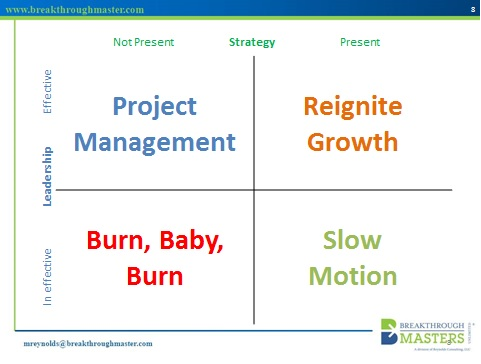The statistics around growth are shocking. Most companies desire it, but few achieve it.
Twenty percent don’t care. Thirteen percent achieve single-digit sustainable growth for 10 years or more. The other 67 percent of us? Either we are growing more slowly, or we are yo-yoing, with increases and decreases that keep us hovering at or around the same mark. In this case, being in the majority is not desirable. What can you do about it? Maybe more than you think. It may be your leadership that helps or hinders your company’s ability to grow.
Beating the market (or outperforming your peers) over time requires a strong strategy and great execution. What I have found is that leaders tend to be better at one than the other. Yet in a growth company, both are needed. In this chart, the upper right is the desirable place for growth-oriented companies to be. However, as the statistics show, most of us fall into one of the other quadrants.
Which Are You?
If you are an effective leader, but strategy is lacking, you are most likely a project manager and defined by the following:
- Develops overall goals and targets
- Strategic plan is a list of projects and initiatives often developed by functional areas
- “Strategic plans” happen annually
- Has a process for accountability
- Rockefeller Habits
- Great Game of Business
- Covey’s 4 Disciplines of Execution
The flaws of this leadership style when it comes to strategic growth include:
- Looking for answers in operations—focuses internally more than externally
- Too many projects—lack aligning focus
- Projects are driven by functional area, not overarching concept
- Me-Too Solutions—looks to benchmark against competitors
- Goal is incremental growth
- Only one out of four strategic initiatives returns value
On the other hand, if you are a great strategist but struggle with getting things done, it may feel like you are on a merry-go-round struggling to get closure on projects or moving much slower than you had hoped. These traits may seem familiar:
- Establishes vision and mission
- Determines strategic focus
- Strategic plans occur every three to five years
- Goal is exponential growth
- Puts culture on the wall
Unfortunately, you may experience these challenges:
- Actions not clearly defined
- Organizational silos and culture resistance
- Inconsistent progress
- Focuses on activities—little accountability for results
- Fights the pull of business gravity—stays tethered to status quo
- Resources not aligned with priorities—strategic initiatives not integrated into regular work efforts
- 80 percent of strategic plans don’t get implemented effectively
If you find yourself in either of these buckets, realize awareness is step one of changing the paradigm. Next is to focus your efforts on filling in the gap. What can help? Because so many leaders need help getting to the upper right quadrant, we developed the 3D Breakthrough Solution designed to Reignite Growth. It consists of three different phases.
Discovery
The first D is for Discovery, and regardless of what type of leader you are, discovery helps orient the team to the same industry data, ensuring a more objective and accurate assessment of your company’s market and strategic opportunities. That results in greater confidence when making bigger, strategic decisions. You can step outside of the tactical efforts and embrace more transformative opportunities.
Development
The second D is for Development and encourages a strategic choice be made that defines the organization’s future direction and competitive advantage. It should define success and provide a clear focus for where you play and how you win. If you are a “project manager,” this D is critical to push the tasks your organization defines and completes to a more significant and synergistic level.
Delivery
The third D is for Delivery, and it is in this stage where strategic ideas and initiatives get connected to people and resources. In other words, it is where the rubber meets the road and strategies live or die. If you find yourself in the lower right, having difficulty making progress, this is the D to work on.



